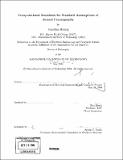Computational soundness for standard assumptions of formal cryptography
Author(s)
Herzog, Jonathan, 1975-
DownloadFull printable version (5.197Mb)
Other Contributors
Massachusetts Institute of Technology. Dept. of Electrical Engineering and Computer Science.
Advisor
Ron Rivest.
Terms of use
Metadata
Show full item recordAbstract
This implementation is conceptually simple, and relies only on general assumptions. Specifically, it can be thought of as a 'self-referential' variation on a well-known encryption scheme. 4. Lastly, we show how the computational soundness of the Dolev-Yao model can be maintained even as it is extended to include new operators. In particular, we show how the Diffie-Hellman key-agreement scheme and the computational Diffie-Hellman assumption can be added to the Dolev-Yao model in a computationally sound way. The Dolev-Yao model is a useful and well-known framework in which to analyze security protocols. However, it models the messages of the protocol at a very high level and makes extremely strong assumptions about the power of the adversary. The computational model of cryptography, on the other hand, takes a much lower-level view of messages and uses much weaker assumptions. Despite the large differences between these two models, we have been able to show that there exists a relationship between them. Previous results of ours demonstrate that certain kinds of computational cryptography can result in an equivalence of sorts between the formal and computational adversary. Specifically: * We gave an interpretation to the messages of the Dolev-Yao model in terms of computational cryptography, * We defined a computational security condition, called weak Dolev-Yao non-malleability, that translates the main assumptions of the Dolev-Yao model into the computational setting, and * We demonstrated that this condition is satisfied by a standard definition of computational encryption security called plaintext awareness. In this work, we consider this result and strengthen it in four ways: 1. Firstly, we propose a stronger definition of Dolev-Yao non-malleability which ensures security against a more adaptive adversary. 2. Secondly, the definition of plaintext awareness is considered suspect because it relies on a trusted third party called the random oracle. Thus, we show that our new notion of Dolev-Yao non-malleability is satisfied by a weaker and less troublesome definition for computational encryption called chosen-ciphertext security. 3. Thirdly, we propose a new definition of plaintext-awareness that does not use random oracles, and an implementation.
Description
Thesis (Ph. D.)--Massachusetts Institute of Technology, Dept. of Electrical Engineering and Computer Science, 2004. Includes bibliographical references (p. 95-100).
Date issued
2004Department
Massachusetts Institute of Technology. Department of Electrical Engineering and Computer SciencePublisher
Massachusetts Institute of Technology
Keywords
Electrical Engineering and Computer Science.